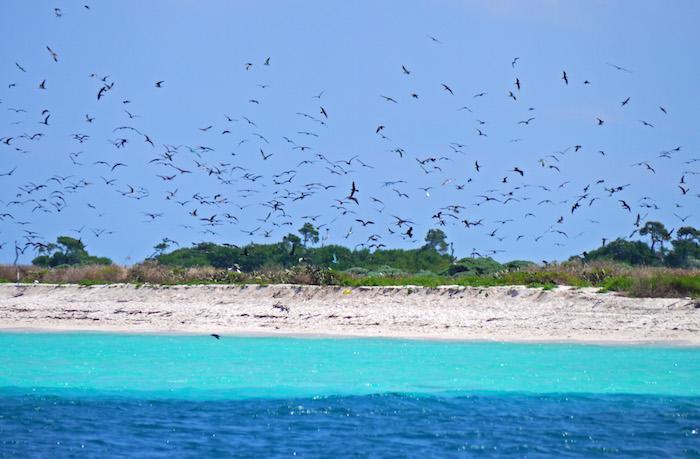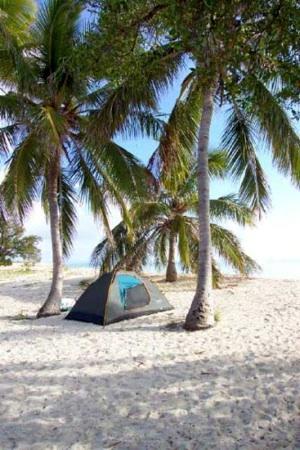
Dry Tortugas offers more than a single day visit can handle, from birding and snorkeling to fishing and scuba diving and history lessons/NPS
Freeman Tilden brushed on the military history of a small clutch of coral cayes when he mentioned Fort Jefferson National Monument in The National Parks, but the brief entry did little justice to the place known today as Dry Tortugas National Park.
Seventy miles off the southern tip of Florida, the park today harbors not only Civil War history in massive, and incomplete, Fort Jefferson, but its marine resources are spectacular, and its sunken wrecks tell tales from the days when wind, not fuel oil, powered ships. The natural beauty is reason enough to visit,
“I lied there and thought that the island at night would be the memory that would stick with me most,” wrote Mark Woods of Dry Tortugas in Lassoing the Sun: A Year In America's National Parks, which described his year-long odyssey of national park adventures. “Then I woke up to the first rays of sunlight on my final morning here.”
What Woods saw was water, “so mirror smooth that it was hard to tell where light blue fluid ended and light blue air began. The boats in the harbor appeared to be floating in midair.”
Birdlife -- Brown pelicans, Masked boobies, Brown noddies, and the Magnifcent frigatebirds -- also float in midair over the park, while Sooty terns wheel in the skies. Those terns have been studied for decades as "an indicator species for open ocean-level ecosystem processes; if their populations decline, it's considered a warning sign for the open ocean," Erika Zambello wrote for the Traveler back in 2017. "Tracking them to see where they go gave scientists a better understanding of what ocean area they 'monitor.'"

The health of Sooty terns at Dry Tortugas is a good indicator of the health of the oceans/Erika Zambello
Dip your head beneath the surrounding water's surface and you'l find an enchanting world of marine life.
Five species of sea turtles are regulars in the park’s waters, while the coral reefs serve as condominiums for a wide array of marine life. Snorkel or scuba dive here and you’re likely to encounter turtles, lobsters, squid, octopus, Goliath groupers, and endless species of multi-hued fish. Darting yellows likely will be smallmouth grunts, the red you spot could be a grouper, while a curtain of gray could be formed by snappers.
For scuba divers prepared to stay underwater, there are plenty of cultural resources worth exploring. One of the most popular, and easily accessible, shipwrecks in the park is the Avanti, located just south of Loggerhead Key. It even has a mooring ball provided for day use. Commonly referred to as the windjammer wreck, the Avanti was a steel-hulled sailing vessel that ran aground on the loggerhead reef in the early 1900s.
Before diving this site, be sure to pick up a laminated underwater map at the visitor center. This map will provide you with a self-guided tour of the wreck and allow you to make sense of what you are seeing. Depths on this site range from zero feet, where a small piece of wreckage actually breaks the surface, to 20 feet. It is a perfect place for snorkelers and scuba buffs to dive together. The best visibility on the site is during flood tide. The wreck has the greatest relief from the bottom and the most marine life at the very bow and the very stern of the wreckage. Consult the map to see how to locate those points since the ship is broken in half and you may become a bit confused without the guide.
How do you get to Dry Tortugas, where do you stay?
You can fly there by seaplane, though that can be somewhat pricey, with full-day adult prices at $600 in 2018. Or you can take the Yankee Freedom III (Full disclosure: This company is a Traveler advertiser). That option is definitely less expensive, but still $175 for an adult round-trip ticket.

Camping at Garden Key in Dry Tortugas National Park/NPS
Facing that kind of expense, you'll want to make the most of your Dry Tortugas adventure by spending two or three days at the park. The only accommodations is the 10-site Garden Key Campground, where you need to bring everything you'll need for your stay, including fresh water and fuel for cooking. The seaplane can't help you here, but the Yankee Freedom III can, and you can even arrange to have the ferry carry your own kayak across the 70 miles of ocean to the park. Bring your fishing tackle and you might be able to enjoy fresh fish for dinner.
Just imagine, when the day visitors leave, you're pretty much alone on the Dry Tortugas with perhaps another 8-10 campers. Stars wheel overhead at night, birds during the day.
And when your head is not beneath the water, keep an eye on the skies.
Nearly 300 hundred species of birds have been spotted in the Dry Tortugas. With some species like the magnificent frigate bird, and sooty terns, nesting nowhere else in the continental united states, except for the islands of the Dry Tortugas. Imagine 100,000 sooty terns all coming home to roost on a tiny speck of land in the middle of the Gulf of Mexico.
Spring is the best season for birding, according to the Park Service.
And if marine science peaks your interest, the park's Research Natural Area that was established in 2007 protects 46-square miles of open water (and coral reefs) to help "restore ecological integrity and capacity for self-renewal by minimizing human disturbance." While fishing isn't allowed inside the RNA, naturally, you can snorkel and scuba dive there.
Finally, not to be overlooked, is Fort Jefferson, a fort that took an estimated 16 million bricks and 30 years to complete with a goal of guarding the Florida Straits and protecting the Gulf states from attack. The fort "was planned as a (late) reaction to the War of 1812. After the British burned Washington, D.C., Congress authorized Fort Jefferson and several similar forts up and down the East Coast, including Fort Sumter in South Carolina and Fort Pulaski in Georgia," Traveler contributor Danny Bernstein noted in 2013 after she visited the park.
"The six-sided fort with three levels was designed to hold 450 cannons and 1,500 men. The walls are between eight and 11 feet thick. A moat surrounds the structure to prevent storm surges from hitting the fort full force. The fort was built with many casemates (gun rooms), but not one shot was ever fired in anger from here."
Yes, it takes an effort to reach Dry Tortugas National Park, but once there you'll appreciate that effort.
Traveler's choice for: Snorkeling, scuba diving, birding, solitude, history

The Research Natural Area at Dry Tortugas National Park/NPS






Add comment